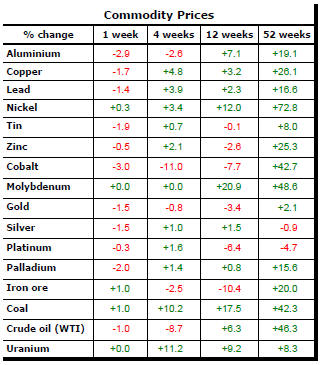The Current View
A lengthy downtrend in sector prices had given way to a relatively stable trajectory after mid 2013 similar to that experienced in the latter part of the 1990s and first few years of the 2000s.
The late 1990s and early 2000s was a period of macroeconomic upheaval during which time sector pricing nonetheless proved relatively stable.
Relative stability suggests a chance for companies genuinely adding value through development success to see their share prices move higher. This was the experience in the late 1990s and early 2000s.
Still vulnerable cyclical conditions were aggravated in the second half of 2015 by a push from investors worldwide to reduce risk. Sector prices were pushed to a new cyclical low. These conditions were reversed through 2016 and 2017 although sector prices have done little more than revert to the 2013 levels which had once been regarded as cyclically weak.
With a median decline in prices of ASX-listed resources companies through the cycle of 89%(and 30% of companies suffering a decline of more then 95%), the majority of stocks remain prone to strong 'bottom of the cycle' leverage in response to even slight improvements in conditions.
Has Anything Changed?
The strength of the US dollar exchange rate since mid 2014 had added an unusual weight to US dollar prices. Reversal of some of the currency gains has been adding to commodity price strength through 2017.
Signs of cyclical stabilisation in sector equity prices has meant some very strong ‘bottom of the cycle’ gains.
Funding for project development has passed its most difficult phase with the appearance of a stronger risk appetite.

Resource Sector Weekly Returns

Market Breadth Statistics

52 Week Price Ranges

Equity Markets




Markets were hovering near record levels at the end of the week despite renewed threats of a tit for tat trade dispute between the USA and China.
The initial confirmation that tariffs were being applied to Chinese goods (as well as goods from other countries) caused markets to fall but the each threatened escalation has been followed by a lessened market response.
Some are inclined to think that President Trump's negotiating style is to talk tough to force a show deal which falls well short of the initial rhetoric. Meanwhile, China has withdrawn whatever it had presented previously as a compromise as it promises to meet every US move with one of its own although, given the trade imbalance, reactions from China will have to extend beyond tariffs.
The downward trend in emerging markets persists. A combination of structural impediments to growth, rising US interest rates and the risks of being caught in a trade war crossfire have contributed to the weakness as did previously rising oil prices.
Within the US market, the dominance of a handful of technology stocks contributing disproportionately to market value continues to drive the capitalisation weighted indexes higher. A 70 percentage point spread in performance since the start of 2017 across the main S&P 500 segments highlights the disparity in performance.
Resource Sector Equities
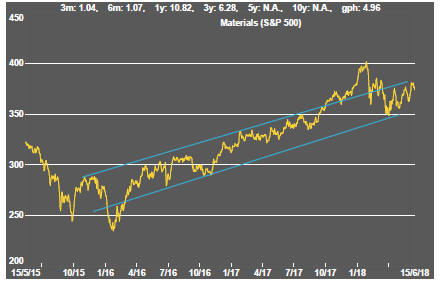



Resources sector equity prices finished the week heading lower. The end of week weakness had not shown through fully during Australian trading time.
The smallest stocks in the sector once again fared worse as the trend away from risk assets filtered through the resources sector.
Australian gold stocks bucked the slippage in the gold price, helped partly by the weaker Australian dollar.
Interest Rates


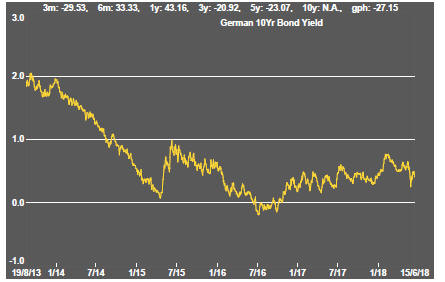

US 10 year bond yields remained under the 3% barrier helping to shore up equity market prices.
Italian government bond yields remained elevated but lower than in the two weeks prior when fears about a political impasse were at their most intense. German yields had reversed most of their previous decline as the flight to safety became less pronounced but remained a drag on yields generally with residual fears about European growth and political instability.
Low rated corporate bond yields edged lower suggesting some of the best industry financing conditions in over a year.
The Federal Reserve decision to raise its Fed Funds rate for the seventh time (amid forecasts that it would hike another five times before the end of 2019 )left a narrower spread between short dated and long dated securities raising the prospect of financial markets not sharing the view of the central bank about the outlook for the US economy.
Exchange Rates




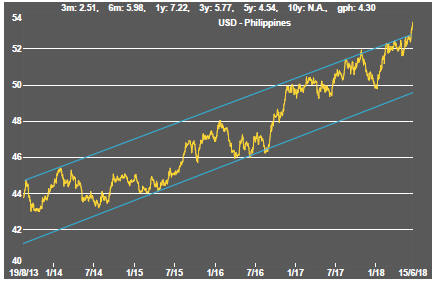

The US dollar recovered losses from the previous week as evidence mounted that US interest rates are set to rise faster in 2018 than rates in other markets. Capital flows reflecting risks to growth were also favouring the US dollar.
Developing country exchange rates continued to face downward pressure. Individual differences in the causes of currency weakness have started to merge into a theme into which the Australian dollar has been pulled. The Australian currency appears to have fallen out of its upward trend which dates from early 2016 with a threat of reverting to where it had been in late 2015.
Commodity Prices

The general upswing in commodity prices since mid 2017 had been given added impetus by stronger crude oil prices which have now eased back, taking the CRB commodities index lower over the past two weeks.
Prices remain within the bounds of a cyclical trough, albeit at the upper end.
The flip side of the benefits for commodity producers and exporters of higher commodity prices is the cost pressure now being experienced by users of agricultural and raw material commodities. Reporting companies have been suggesting this as a source of margin compression.
Business surveys closely watched by central banks are showing signs of upward pressure on selling prices as a result of higher raw material prices.
Gold & Precious Metals







Across the precious metal sector, prices have appeared close to a turning point as they butt up against the bounds of prior trading ranges. By the end of the week, the gold price uptrend had been broken and the silver price had failed in an attempt to break higher.
The divergence in trend between Australian and north American gold related equities remains evident with US markets more aligned with a sceptical view of the near term future of precious metal prices and the Australian market helped by a weaker Australian dollar.
Nonferrous Metals



Metal prices were heading lower at the end of the week amid sign of poorer then previously expected growth outcomes and a rebound in US dollar exchange rates.
Prices of the main daily traded nonferrous metals had previously broken into three groups. Group one comprised those metals affected by US sanctions on Russian economic and political interests, namely nickel and aluminum. The second group included those metals being driven by broader macro trends which are showing up as a loss of growth momentum. The third category comprised tin alone.
Nickel prices have remained strong but, otherwise, signs of convergence and the dominance of broader macro factors, have re-emerged.
Copper prices gave back gains from the prior week, consistent with the direction of bond yields which indicate some scepticism about the growth trajectory. Movements in copper prices are consistent with a cyclcical turn although it might be too early to draw a firm conclusion about that from recent price action.
Bulk Commodities
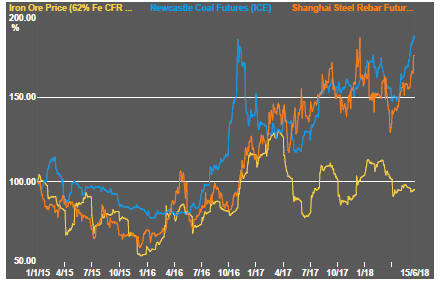
Relatively weak first quarter Chinese GDP growth had suggested a ramp up in activity through the remainder of 2018 if China was going to meet its growth target which, in a centrally controlled economy in which leaders are trying to maintain credibility, is a reasonable assumption.
Iron ore prices have failed to reflect the ongoing expansion in manufacturing output although coal and steel prices have been climbing.
Oil and Gas


Crude oil prices had reached the highest levels in several years before breaking lower after comments from major producers that a production increase might be contemplated and reports of Russian president Vladimir Putin saying that a $60/bbl oil price would be adequate.
The sharp market response to the slightly more bearish tone might lead to some reconsideration of any plans to push output higher.
US production, in any event, continues to rise. US producers are able to profitably hedge anticipated production contributing to the ongoing rise in their output.
Battery Metals


Eighteen months of rising lithium-related stock prices gave way to a period of market reassessment as a lengthy pipeline of potential new projects raised the prospect, although not conclusively, of ongoing supplies being adequate for expected needs.
Potential lithium producers have been able to respond far more quickly to market signals than has been the case in other segments of the mining industry with development prospects.
Movements in lithium related equity prices have been aligned more closely with overall sector equity prices in recent weeks.

Battery metals remain a focal point for investors with recent attention moving to cobalt and vanadium.
Doubts about a peaceful transfer of political power in the Democratic Republic of the Congo (and an Ebola outbreak) added a dimension to cobalt prices lacking in other metals caught up in the excitement over transport electrification. Improved political conditions leave cobalt prices at risk of some retracement.
In the longer term, cobalt is the most vulnerable of the battery related metals to substitution with high prices likely to stimulate research in that direction.
Uranium


The uranium sector is forming a cyclical trough as market balances slowly improve. Power utilities are still not prepared to re-enter the market for contracted amounts of metal to meet longer term needs. A slight upward bias in prices was evident in the past month.
Slightly higher equity prices from time to time, in the hope of improved conditions, have not been sustained but could be repeated as speculation about improved future demand ebbs and flows.
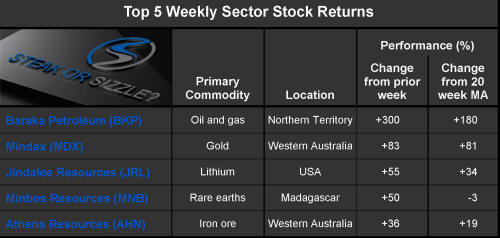
The Steak or Sizzle? blog LINK contains additional commentary on the best performed stocks in the sector and the extent to which their investment outcomes are underpinned by a strong enough value proposition to sustain the gains.

